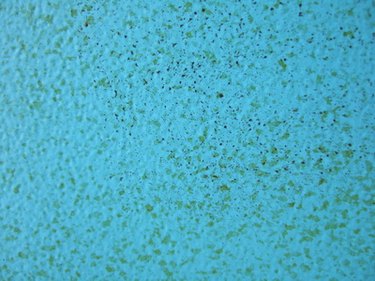
The joy of finishing a tough paint project can quickly fade if you realize youâ??ve left a huge mess behind. Anytime you use a paint gun or air gun, you run the risk of facing overspray, which happens when the spray from the gun blows or spreads to surfaces surrounding your work station. Oil based paints can create brilliant works of art and finishes for projects, but they can also represent a cleaning nightmare if overspray ruins your floors or walls. There are a number of products that can dissolve oil based paints to help you clean things up.
Solid Surfaces
Video of the Day
Step 1
Blot away as much of the paint as you can with a paper towel or drop cloth. Do not rub, as rubbing can force the paint deeper into the surface. For surfaces such as walls, use a plastic scraper to get rid of any already-dried paints
Video of the Day
Step 2
Dampen a paper towel or cloth in paint thinner recommended for oil based paint; read all product instructions and warnings to determine if the product will work with oil based paint. You can substitute thinner with rubbing alcohol or turpentine if necessary.
Step 3
Dab your chosen solvent onto the spots of oil paint. Allow the solvent to work for two minutes and then dab up the loosened paint and residual solvent with a clean towel or cloth.
Step 4
Reapply solvent and dab to remove all loosened paint until the paint is completely gone. Rinse the surface in a clean cloth dampened with cool water to remove residual solvent.
Fabrics and Carpet
Step 1
Blot away as much of the paint as you can with a paper towel or drop cloth. Do not rub, as rubbing can force the paint deeper into the surface. Use the blunt edge of a dull knife or spoon to remove any already-dried paint.
Step 2
Dampen a paper towel or cloth with a citrus-based solvent. Apply the solvent lightly to painted areas, starting at the outside of the stain and working your way in. Do not saturate the fabric or carpet, as solvents can cause discoloring or other damage.
Step 3
Allow the solvent to work for two minutes. Blot up the solvent with clean white paper towels or rncloths to remove the paint stains.
Step 4
Mix 2 tbsp. ammonia with 1 cup warm water for a homemade solvent, or if the solvent does not dissolve the paint. You can also use a mixture of 1 cup of white vinegar in 2 cups of water. Apply, rinse and blot as you would with the solvent until the stain is gone.
Tip
Treat oil based paint overspray as soon as you notice it; the paint is much easier to clean when wet than when it has had time to dry.rnrnIf the solvent fails to work on the carpet or fabric stains, mix
Warning
Many solvents, including paint thinner, rubbing alcohol and turpentine, are highly flammable and toxic. Ventilate your work area before you begin and never use direct heat near the solvents.rnrnDo not mix chemical solvents, such as paint thinner with ammonia. These chemicals can have dangerous chemical reactions.